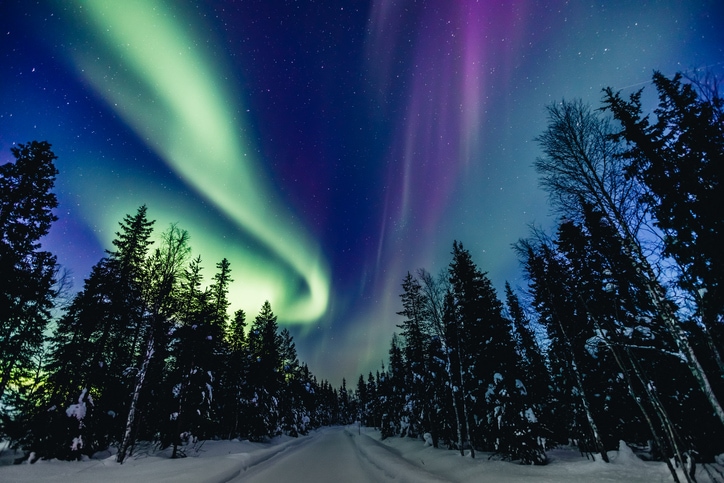How Long Do Aurora Borealis Displays Typically Last?
At VALO Finland, we are passionate about sharing the wonders of Lapland with our guests. One of the most enchanting experiences you can have in this magical region is witnessing the aurora borealis, or northern lights. But how long do these mesmerising displays typically last? In this blog post, we will delve into the factors that influence the duration of an aurora display, the average duration, seasonal variations, and tips for maximising your aurora viewing time.
What is the Aurora Borealis?
The aurora borealis, commonly known as the northern lights, is a natural light display predominantly seen in high-latitude regions around the Arctic and Antarctic. This phenomenon occurs when charged particles from the sun collide with atoms in Earth’s atmosphere, causing bursts of light. These lights can appear in various colours, including green, pink, red, yellow, and blue, and often form dynamic patterns such as arcs, curtains, and spirals.
In Finnish Lapland, the aurora borealis is a frequent visitor, making it one of the best places in the world to witness this celestial spectacle. The lights are most commonly seen between late August and April, when the nights are long and dark enough to provide optimal viewing conditions.
Factors Influencing the Duration of an Aurora Display
Several factors can influence the longevity of aurora borealis displays. One of the primary factors is solar activity. The sun emits a constant stream of charged particles known as the solar wind. When solar activity is high, such as during solar flares or coronal mass ejections, the influx of particles can lead to more intense and prolonged aurora displays.
Geomagnetic activity also plays a crucial role. The Earth’s magnetic field interacts with the solar wind, and during periods of high geomagnetic activity, the auroras can be more vibrant and last longer. Additionally, local weather conditions, such as cloud cover and light pollution, can affect the visibility and duration of the aurora borealis.
Lastly, the time of night can impact the duration of the display. Auroras are typically more active around midnight, but they can occur at any time during the night when the sky is dark enough.
Average Duration of Aurora Borealis Displays
On average, aurora borealis displays can last anywhere from a few minutes to several hours. Short-lived displays may only be visible for a brief period, while more extended displays can last for hours, providing a prolonged and captivating experience. The intensity and duration of the aurora can vary significantly from one night to the next, making each sighting a unique event.
In Finnish Lapland, it is not uncommon to witness multiple aurora displays in a single night, especially during periods of high solar and geomagnetic activity. This variability adds to the excitement and allure of aurora hunting, as you never know exactly what to expect.
Seasonal Variations in Aurora Display Duration
The duration of aurora borealis displays can also vary with the seasons. In Lapland, the best time to see the northern lights is from late August to April. During this period, the nights are long and dark, providing ample opportunities for aurora viewing. However, the duration and frequency of displays can fluctuate throughout the season.
Autumn and spring are often considered the most active aurora seasons. During these times, the Earth’s magnetic field is more likely to interact with the solar wind, leading to more frequent and prolonged displays. Winter, with its long, dark nights, also offers excellent viewing conditions, although the cold temperatures can be challenging for some visitors.
In contrast, the summer months in Lapland experience the phenomenon of the midnight sun, where the sun does not set, making it impossible to see the auroras. Therefore, planning your visit during the optimal aurora season is essential for maximising your chances of witnessing this natural wonder.
Travel Tips for Maximising Aurora Viewing Time
To make the most of your aurora viewing experience, consider the following tips:
- Choose the Right Time: Plan your visit between late August and April, with autumn and spring being the most active seasons for auroras.
- Head North: The farther north you go, the better your chances of seeing the northern lights. Lapland, especially around the Arctic Circle, offers some of the best viewing opportunities.
- Monitor the Weather: Clear, dark skies are essential for aurora viewing. Keep an eye on local weather forecasts and be prepared to move to different locations if necessary.
- Check Aurora Forecasts: Use online resources and apps to monitor geomagnetic activity and receive alerts when auroras are likely to occur.
- Dress Warmly: Northern Finland can be extremely cold, especially at night. Dress in layers and bring warm clothing to stay comfortable while waiting for the auroras to appear.
- Join a Guided Tour: Consider joining an aurora hunting tour with experienced guides who know the best spots and times for viewing the northern lights.
At VALO Finland, we are dedicated to helping you create unforgettable memories in Lapland. Our luxury villas provide the perfect base for your aurora hunting adventures, offering comfort and convenience in the heart of this magical region. Whether you are a seasoned aurora chaser or a first-time visitor, we are here to ensure you have the best possible experience.
In conclusion, the duration of aurora borealis displays can vary widely, influenced by factors such as solar and geomagnetic activity, local weather conditions, and the time of night. By planning your visit during the optimal aurora season and following our travel tips, you can maximise your chances of witnessing this breathtaking natural phenomenon. We invite you to explore the wonders of Lapland with us at VALO Finland, where adventure and luxury await.
